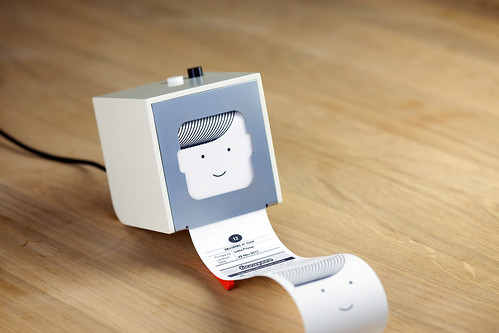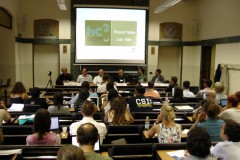Aug 04, 2012
Extending body space in immersive virtual reality: a very long arm illusion
PLoS One. 2012;7(7):e40867
Authors: Kilteni K, Normand JM, Sanchez-Vives MV, Slater M
Abstract. Recent studies have shown that a fake body part can be incorporated into human body representation through synchronous multisensory stimulation on the fake and corresponding real body part - the most famous example being the Rubber Hand Illusion. However, the extent to which gross asymmetries in the fake body can be assimilated remains unknown. Participants experienced, through a head-tracked stereo head-mounted display a virtual body coincident with their real body. There were 5 conditions in a between-groups experiment, with 10 participants per condition. In all conditions there was visuo-motor congruence between the real and virtual dominant arm. In an Incongruent condition (I), where the virtual arm length was equal to the real length, there was visuo-tactile incongruence. In four Congruent conditions there was visuo-tactile congruence, but the virtual arm lengths were either equal to (C1), double (C2), triple (C3) or quadruple (C4) the real ones. Questionnaire scores and defensive withdrawal movements in response to a threat showed that the overall level of ownership was high in both C1 and I, and there was no significant difference between these conditions. Additionally, participants experienced ownership over the virtual arm up to three times the length of the real one, and less strongly at four times the length. The illusion did decline, however, with the length of the virtual arm. In the C2-C4 conditions although a measure of proprioceptive drift positively correlated with virtual arm length, there was no correlation between the drift and ownership of the virtual arm, suggesting different underlying mechanisms between ownership and drift. Overall, these findings extend and enrich previous results that multisensory and sensorimotor information can reconstruct our perception of the body shape, size and symmetry even when this is not consistent with normal body proportions.
20:03 Posted in Telepresence & virtual presence, Virtual worlds | Permalink | Comments (0)
The therapeutic relationship in e-therapy for mental health: a systematic review
J Med Internet Res. 2012;14(4):e110
Authors: Sucala M, Schnur JB, Constantino MJ, Miller SJ, Brackman EH, Montgomery GH
Abstract BACKGROUND: E-therapy is defined as a licensed mental health care professional providing mental health services via e-mail, video conferencing, virtual reality technology, chat technology, or any combination of these. The use of e-therapy has been rapidly expanding in the last two decades, with growing evidence suggesting that the provision of mental health services over the Internet is both clinically efficacious and cost effective. Yet there are still unanswered concerns about e-therapy, including whether it is possible to develop a successful therapeutic relationship over the Internet in the absence of nonverbal cues. OBJECTIVE: Our objective in this study was to systematically review the therapeutic relationship in e-therapy. METHODS: We searched PubMed, PsycINFO, and CINAHL through August 2011. Information on study methods and results was abstracted independently by the authors using a standardized form.
RESULTS: From the 840 reviewed studies, only 11 (1.3%) investigated the therapeutic relationship. The majority of the reviewed studies were focused on the therapeutic alliance-a central element of the therapeutic relationship. Although the results do not allow firm conclusions, they indicate that e-therapy seems to be at least equivalent to face-to-face therapy in terms of therapeutic alliance, and that there is a relationship between the therapeutic alliance and e-therapy outcome. CONCLUSIONS: Overall, the current literature on the role of therapeutic relationship in e-therapy is scant, and much more research is needed to understand the therapeutic relationship in online environments.
20:01 Posted in Cybertherapy | Permalink | Comments (0)
Visualising the Emotional Response to LONDON 2012
Reblogged from InfoAesthetics

The Emoto visualization by the illustrious Moritz Stefaner, FutureEverything, and Studio NAND tracks twitter for themes related to the Games, analyzes the messages for content and emotional expressions, and visualizes topics and tone of the conversation. You can find out which topics are most discussed, or see all current messages related to the Games.
Emoto uses an origami looking glyph to represent the emotive summarization for each topic. The glyphs reshape and rearrange themselves based on realtime status. You can also view an overview of each day.
After the games, a set of data sculptures will be made to capture the collective emotion of the 2012 Olympics.
Kim Rees is a partner at Periscopic, a socially-responsible data visualization firm.
19:46 Posted in Information visualization | Permalink | Comments (0)
Is Little Printer the next (little) thing?
Yes! Definitely yes!
Little Printer lives in your home, bringing you news, puzzles and gossip from your friends. Use your smartphone to set up subscriptions and Little Printer will gather them together to create a timely, beautiful mini-newspaper.
For more see:
bergcloud.com/littleprinter/

19:34 Posted in Blue sky | Permalink | Comments (0)
The Age of ‘Wearatronics’
Medgadget has an interesting article on the raise of ‘Wearatronics’, a new trend in which new materials and interconnects have made circuit assemblies flexible and, as a result, embeddable. Such flexible electronic arrays may be embedded into textiles in order to, for example, measure the wearer’s vital signs or even generate and store power.
According to GigaOm's research report The wearable-computing market: a global analysis the wearatronics market for just health and fitness products is estimated to reach 170 million devices within the next five years.
In this video, Bloomberg's Sheila Dharmarajan reports on the outlook for wearable electronics on Bloomberg Television's "Bloomberg West." (Source: Bloomberg)
Also interesting is this TED speech from David Icke, who creates breathable, implantable microcomputers that conform to the human body, which can be used for a variety of medical applications.
18:10 Posted in Future interfaces, Pervasive computing, Wearable & mobile | Permalink | Comments (0)
A Real-Time fMRI-Based Spelling Device Immediately Enabling Robust Motor-Independent Communication
Curr Biol. 2012 Jun 27;
Authors: Sorger B, Reithler J, Dahmen B, Goebel R
Abstract. Human communication entirely depends on the functional integrity of the neuromuscular system. This is devastatingly illustrated in clinical conditions such as the so-called locked-in syndrome (LIS) [1], in which severely motor-disabled patients become incapable to communicate naturally-while being fully conscious and awake. For the last 20 years, research on motor-independent communication has focused on developing brain-computer interfaces (BCIs) implementing neuroelectric signals for communication (e.g., [2-7]), and BCIs based on electroencephalography (EEG) have already been applied successfully to concerned patients [8-11]. However, not all patients achieve proficiency in EEG-based BCI control [12]. Thus, more recently, hemodynamic brain signals have also been explored for BCI purposes [13-16]. Here, we introduce the first spelling device based on fMRI. By exploiting spatiotemporal characteristics of hemodynamic responses, evoked by performing differently timed mental imagery tasks, our novel letter encoding technique allows translating any freely chosen answer (letter-by-letter) into reliable and differentiable single-trial fMRI signals. Most importantly, automated letter decoding in real time enables back-and-forth communication within a single scanning session. Because the suggested spelling device requires only little effort and pretraining, it is immediately operational and possesses high potential for clinical applications, both in terms of diagnostics and establishing short-term communication with nonresponsive and severely motor-impaired patients.
17:55 | Permalink | Comments (0)
Non-Pharmacological Cognitive Enhancement
Neuropharmacology. 2012 Jul 21;
Authors: Dresler M, Sandberg A, Ohla K, Bublitz C, Trenado C, Mroczko-Wasowicz A, Kühn S, Repantis D
Abstract. The term "cognitive enhancement" usually characterizes interventions in humans that aim to improve mental functioning beyond what is necessary to sustain or restore good health. While the current bioethical debate mainly concentrates on pharmaceuticals, according to the given characterization, cognitive enhancement also by non-pharmacological means has to be regarded as enhancement proper. Here we summarize empirical data on approaches using nutrition, physical exercise, sleep, meditation, mnemonic strategies, computer training, and brain stimulation for enhancing cognitive capabilities. Several of these non-pharmacological enhancement strategies seem to be more efficacious compared to currently available pharmaceuticals usually coined as cognitive enhancers. While many ethical arguments of the cognitive enhancement debate apply to both pharmacological and non-pharmacological enhancers, some of them appear in new light when considered on the background of non-pharmacological enhancement.
17:49 Posted in Brain training & cognitive enhancement | Permalink | Comments (0)
The Virtual Brain
The Virtual Brain project promises "to deliver the first open simulation of the human brain based on individual large-scale connectivity", by "employing novel concepts from neuroscience, effectively reducing the complexity of the brain simulation while still keeping it sufficiently realistic".
The Virtual Brain team includes well-recognized neuroscientists from all over the world. In the video below, Dr. Randy McIntosh explains what the project is about.
First teaser release of The Virtual Brain software suite is available for download – for Windows, Mac and Linux: http://thevirtualbrain.org/
13:34 Posted in Blue sky, Neurotechnology & neuroinformatics, Research tools | Permalink | Comments (0)
New HMD "Oculus RIFT" launched on Kickstarter
The Oculus Rift, a new HMD which promises to take 3D gaming to the next level, was launched on Kickstarter last week. The funding goal is $250,000.
“With an incredibly wide field of view, high resolution display, and ultra-low latency head tracking, the Rift provides a truly immersive experience that allows you to step inside your favorite game and explore new worlds like never before."
Technical specs of the Dev Kit (subject to change)
Head tracking: 6 degrees of freedom (DOF) ultra low latency
Field of view: 110 degrees diagonal / 90 degrees horizontal
Resolution: 1280×800 (640×800 per eye)
Inputs: DVI/HDMI and USB
Platforms: PC and mobile
Weight: ~0.22 kilograms
The developer kits acquired through Kickstarter will include access to the Oculus Developer Center, a community for Oculus developers. The Oculus Rift SDK will include code, samples, and documentation to facilitate integration with any new or existing games, initially on PCs and mobiles, with consoles to follow.
Oculus says it will be showcasing the Rift at a number of upcoming tradeshows, including Quakecon, Siggraph, GDC Europe, gamescom and Unite.







